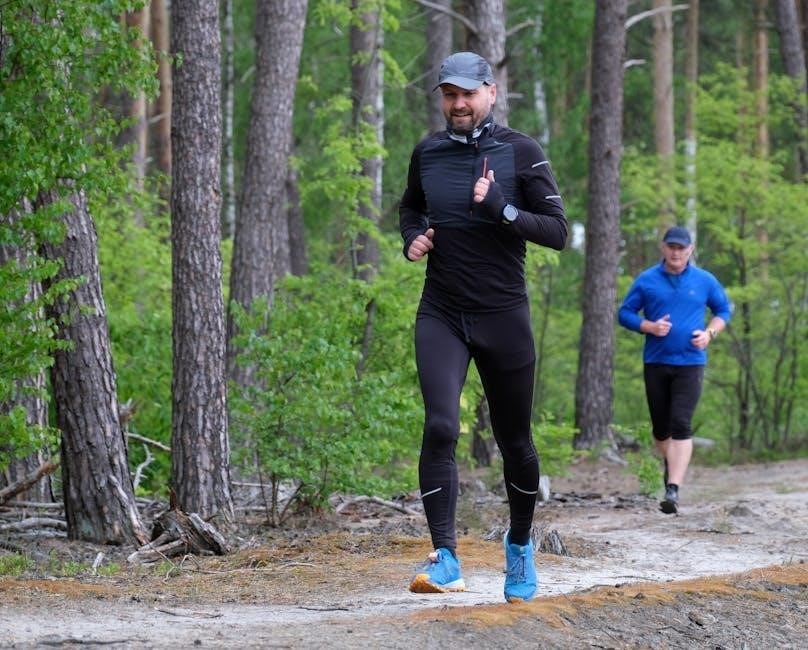trail making test a and b pdf
The Trail Making Test (TMT) is a widely used neuropsychological assessment tool consisting of two parts: Trail A and Trail B. It evaluates cognitive functions such as attention‚ executive functioning‚ and processing speed. TMT-A involves connecting numbers in sequence‚ while TMT-B requires alternating between numbers and letters‚ assessing cognitive flexibility. The test is commonly used in clinical and research settings to assess brain function and driving fitness. Its simplicity and effectiveness make it a valuable instrument in understanding cognitive abilities.
Overview of the Trail Making Test (TMT)
The Trail Making Test (TMT) is a neuropsychological assessment tool widely used to evaluate cognitive function. It consists of two parts: Trail A and Trail B. Trail A requires connecting numbered circles in ascending order‚ while Trail B involves alternating between numbers and letters. The test measures executive function‚ cognitive flexibility‚ and processing speed. It is commonly used in clinical settings to assess brain function‚ detect cognitive impairments‚ and evaluate driving fitness. Its simplicity and effectiveness make it a valuable tool in neuropsychological evaluations.
Importance of TMT in Cognitive Assessment
The Trail Making Test (TMT) is a cornerstone in neuropsychological evaluations‚ providing critical insights into cognitive function. It assesses executive function‚ cognitive flexibility‚ and processing speed‚ which are essential for daily tasks and decision-making. TMT is widely used in clinical settings to detect cognitive impairments‚ monitor progression of neurological disorders‚ and evaluate recovery after brain injuries. Its ability to measure both simple and complex cognitive processes makes it a versatile and valuable tool in understanding brain function and behavior.

Description of the Trail Making Test
The Trail Making Test (TMT) consists of two parts‚ each with 25 circles on a page. Part A involves connecting numbers in sequence‚ while Part B alternates between numbers and letters‚ requiring cognitive flexibility. This neuropsychological tool assesses executive function‚ attention‚ and processing speed‚ providing insights into various cognitive skills essential for everyday functioning.
Structure of Trail Making Test A
Trail Making Test A consists of 25 numbered circles (1 to 25) distributed across a page. The task requires the participant to connect the numbers in ascending order using a pencil‚ starting from 1 and ending at 25. The goal is to complete the trail as quickly as possible without lifting the pencil from the paper. This part assesses basic cognitive functions‚ including visual scanning‚ processing speed‚ and the ability to follow a sequential pattern.
Structure of Trail Making Test B
Trail Making Test B involves 25 circles containing alternating numbers and letters (e.g.‚ 1‚ A‚ 2‚ B‚ 3‚ C‚ etc.). Participants must connect these in ascending order‚ switching between numbers and letters. The task begins at 1 and ends at an alternating sequence of letters and numbers‚ requiring cognitive flexibility and executive functioning. This structure is more complex than Trail A‚ as it demands attention and the ability to switch between two different sequences seamlessly.
Key Differences Between Trail A and Trail B
Trail A involves connecting 25 numbered circles in ascending order‚ assessing processing speed and visual scanning. Trail B requires alternating between numbers and letters (e.g.‚ 1-A-2-B)‚ testing cognitive flexibility and executive functioning. Trail B is more complex‚ demanding task-switching abilities. While Trail A measures basic cognitive skills‚ Trail B evaluates higher-order functions‚ making it more sensitive to executive dysfunction and providing deeper insights into cognitive processes and brain function.

Uses of the Trail Making Test
The Trail Making Test is primarily used for cognitive assessment‚ driving fitness screening‚ and neuropsychological evaluations. It measures executive functioning‚ attention‚ and processing speed‚ aiding in diagnosing brain dysfunction and monitoring cognitive recovery in clinical and research settings.
Assessment of Cognitive Function
The Trail Making Test effectively assesses various cognitive functions‚ including attention‚ executive functioning‚ and processing speed. Part A evaluates visual scanning and simple sequencing abilities‚ while Part B measures cognitive flexibility by requiring alternating sequences between numbers and letters. This distinction helps identify deficits in executive function‚ making TMT a valuable tool in neuropsychological evaluations to detect and monitor cognitive impairments‚ particularly in conditions affecting brain function and recovery processes.
Driving Fitness Screening
The Trail Making Test is widely used to assess driving fitness by evaluating cognitive abilities critical for safe driving. Part A measures attention and processing speed‚ while Part B assesses executive function and cognitive flexibility. Poor performance on TMT‚ particularly in quickly and accurately completing the tasks‚ has been linked to impaired driving abilities. This makes the test a reliable tool for screening individuals whose cognitive deficits may pose risks behind the wheel.
Neuropsychological Evaluation
The Trail Making Test is a key component of the Halstead-Reitan Neuropsychological Battery‚ used to assess executive function‚ attention‚ and cognitive flexibility. TMT-A evaluates processing speed and visual scanning‚ while TMT-B measures the ability to alternate between tasks‚ reflecting executive control. The test helps identify deficits in planning‚ problem-solving‚ and cognitive switching‚ providing insights into brain function and dysfunction in clinical and research settings.

Administration of the Trail Making Test
The test administrator places the form in front of the participant‚ reads instructions aloud‚ and starts timing upon commencement. The process includes both Trail A and Trail B.
Instructions for Trail A
The administrator places the Trail A form in front of the participant and reads the instructions aloud. The participant is told to connect numbered circles in ascending order using a pencil‚ starting at 1 and proceeding sequentially. The administrator demonstrates by pointing to numbers 1‚ 2‚ and 3. Timing begins immediately after the instruction to start‚ and the test continues until completion or the maximum time of 5 minutes is reached.
Instructions for Trail B
The administrator provides the Trail B form and reads the instructions aloud. The participant must connect circles containing numbers and letters in alternating order‚ starting at 1‚ then A‚ 2‚ B‚ and so on. They must do this as quickly as possible without lifting the pencil from the paper. Timing begins immediately after the instruction to start and stops when the test is completed or after reaching the maximum time of 300 seconds (5 minutes).
Timing and Completion Criteria
Timing begins immediately after the participant is instructed to start and stops when the test is completed or after reaching the maximum time of 300 seconds (5 minutes). The test is timed for both Trail A and Trail B. Completion requires connecting all circles in the correct sequence without skipping or repeating numbers. If the participant finishes early‚ timing stops. Errors are noted but not corrected during administration‚ and the test continues until completed or the time limit is reached.

Scoring the Trail Making Test
Scoring the Trail Making Test involves measuring completion time and analyzing errors. Time to complete Trail A and B is recorded in seconds. Fewer errors and faster times indicate better cognitive performance‚ particularly in processing speed and executive function. Reliability and validity of the test are well-established‚ making it a robust tool for neuropsychological assessment.
Time to Completion
Time to completion is a primary metric for scoring the Trail Making Test. For both Trail A and Trail B‚ the administrator records the time taken to finish in seconds. The test begins once instructions are given and stops when the task is completed or the maximum time of 300 seconds (5 minutes) is reached. Faster completion times generally indicate better cognitive performance‚ particularly in processing speed and executive function. Trail B typically takes longer due to its complexity compared to Trail A.
Error Analysis
Error analysis in the Trail Making Test involves identifying incorrect connections‚ missed numbers‚ or failure to alternate between numbers and letters in Trail B. These errors reflect cognitive difficulties‚ such as poor executive function or attention. The number and type of errors are recorded to assess cognitive flexibility and processing accuracy. Higher error rates‚ particularly in Trail B‚ may indicate greater cognitive impairment or challenges in task-switching abilities.
Reliability and Validity
The Trail Making Test demonstrates strong reliability and validity as a neuropsychological assessment tool. Test-retest reliability is moderate to high‚ particularly for Trail B‚ indicating consistent performance across administrations. Validity is supported by its ability to measure cognitive constructs like executive functioning and processing speed effectively. Research confirms its effectiveness in detecting cognitive impairments‚ making it a reliable instrument in both clinical and research settings for evaluating brain function and cognitive abilities accurately.

Factors Influencing Performance
Age‚ education‚ and practice effects significantly influence Trail Making Test performance. Older individuals and those with less education may perform slower‚ while prior exposure improves efficiency‚ particularly in Trail B.
Age and Educational Background
Age and educational background significantly impact Trail Making Test performance. Older individuals often exhibit slower completion times‚ particularly in Trail B‚ due to declining cognitive flexibility. Educational background influences visual scanning and processing speed‚ with higher education linked to better performance. These factors underscore the importance of considering demographic variables when interpreting TMT results to ensure accurate cognitive assessments across diverse populations.
Practice Effects
Practice effects are evident in the Trail Making Test‚ particularly for Trail B‚ where repeated administrations lead to improved performance. Familiarity with the test format enhances cognitive processing‚ reducing completion times. However‚ these effects are less pronounced for Trail A‚ as its straightforward nature limits room for improvement. Understanding practice effects is crucial for interpreting results accurately‚ ensuring reliable assessments of cognitive function and executive abilities across multiple test sessions.
Cultural and Linguistic Considerations
Cultural and linguistic factors significantly influence Trail Making Test performance. Variations in education‚ language‚ and familiarity with testing formats can affect results. For example‚ non-native speakers may face challenges with instructions or letter-number sequencing in Trail B. Adaptations‚ such as translating instructions or creating culturally relevant versions‚ are essential to ensure fairness. Localized norms and test designs help mitigate biases‚ ensuring accurate cognitive assessments across diverse populations‚ such as in Moroccan or Brazilian adaptations.

Normative Data and Interpretation
Normative data for the Trail Making Test (TMT) provides standardized benchmarks for interpreting performance. These norms‚ covering ages 18–89‚ enable clinicians to compare individual results with population averages‚ aiding in accurate cognitive assessments and identifying potential deficits. This data is crucial for evaluating executive function‚ attention‚ and processing speed in diverse clinical and research settings.
Population Norms
The Trail Making Test has established population norms based on large samples across diverse demographics. These norms cover individuals aged 18–89 and account for variables like age and education. Such data enables clinicians to compare individual performance against population averages‚ facilitating accurate cognitive assessments. The norms are essential for identifying deviations in executive function‚ attention‚ and processing speed‚ aiding in early detection of cognitive impairments in clinical settings.
Interpretation Guidelines
Interpretation of the Trail Making Test involves comparing an individual’s performance to population norms‚ considering age and educational background. Completion time and error rates are key metrics. Faster times and fewer errors typically indicate better cognitive functioning. Clinicians use these guidelines to identify impairments in executive function‚ attention‚ or processing speed. Deviations from norms may suggest cognitive deficits‚ guiding further assessment or intervention strategies.
Limitations of the Trail Making Test
The Trail Making Test has certain limitations‚ including potential cultural bias and lack of comprehensiveness. It primarily measures attention and executive function but doesn’t assess other cognitive areas like memory or language. Its reliance on timed performance may also introduce variability. Despite its utility‚ it should be complemented with additional assessments for a broader cognitive evaluation.
Criticisms and Potential Biases
The Trail Making Test faces criticism for its cultural and educational biases‚ as performance can be influenced by background differences. The test may not account for varying linguistic or cultural contexts‚ potentially leading to unfair assessments. Additionally‚ its reliance on timed tasks can create anxiety‚ impacting results. These factors highlight the need for cautious interpretation and supplementation with other tests to ensure comprehensive evaluation.
Alternatives and Supplements
While the Trail Making Test is valuable‚ alternatives like the Stroop Test and Wisconsin Card Sorting Task provide deeper insights into executive functions. Supplements such as the Montreal Cognitive Assessment (MoCA) offer broader cognitive assessments. Combining these tools ensures a more comprehensive evaluation of cognitive abilities‚ addressing potential limitations of the TMT alone. This multi-faceted approach enhances accuracy and provides a fuller understanding of cognitive function.

Cultural Adaptations andTranslations
The Trail Making Test has been translated into multiple languages‚ including Norwegian and Brazilian Portuguese‚ ensuring cross-cultural applicability. Adaptations like the Moroccan TMT-B demonstrate its global utility.
Examples of Adapted Versions
The Trail Making Test has been adapted into multiple languages‚ such as Norwegian and Brazilian Portuguese‚ ensuring cultural relevance. A Moroccan version of Trail B was developed‚ incorporating local linguistic nuances while maintaining the test’s original structure. These adaptations enable cross-cultural assessments‚ making the TMT accessible for diverse populations. Such versions retain the core cognitive evaluation principles while accommodating regional differences‚ ensuring valid and reliable results across different cultural contexts.
Challenges in Cross-Cultural Application
Adapting the Trail Making Test for cross-cultural use presents challenges‚ including ensuring equivalence in linguistic and educational backgrounds. Differences in familiarity with standardized testing and varying levels of formal education can affect performance. Cultural biases may influence task interpretation‚ potentially leading to inaccurate results. Additionally‚ normative data must be re-established for each adapted version‚ complicating comparisons across diverse populations. These factors highlight the need for careful validation to maintain the test’s reliability and validity internationally.

Case Studies and Examples
Sample TMT forms demonstrate test administration‚ with numbered circles for Trail A and alternating numbers/letters for Trail B; Real-world applications include clinical assessments and driving evaluations‚ showcasing the test’s practical utility in measuring cognitive function and executive performance across diverse populations.
Sample Test Forms and Solutions
Sample TMT forms provide visual guides for administration. Trail A includes numbered circles (1-25) to be connected in sequence‚ while Trail B alternates numbers and letters (e.g.‚ 1-A-2-B). Solutions demonstrate correct pathways‚ ensuring clarity for evaluators. These samples aid in understanding test structure and scoring‚ helping assess cognitive flexibility‚ processing speed‚ and executive function effectively. They are essential tools for both administrators and participants to grasp test requirements accurately.
Real-World Applications
The Trail Making Test is widely applied in clinical‚ research‚ and driving fitness assessments. It is used to evaluate cognitive impairments in conditions like brain injuries‚ dementia‚ and stroke. TMT is also employed in neuropsychological evaluations to assess executive function‚ attention‚ and processing speed. Its practical applications extend to determining driving eligibility and monitoring cognitive rehabilitation progress‚ making it a versatile tool in both clinical and real-world settings for understanding cognitive health and functional abilities effectively.
The Trail Making Test (TMT) is a cornerstone in cognitive assessment‚ effectively evaluating executive function‚ attention‚ and processing speed. Its versatility in clinical and real-world applications‚ such as driving fitness screening‚ underscores its importance. Continued research is essential to refine its cultural adaptations and ensure validity across diverse populations‚ further solidifying its role in neuropsychological evaluations.
The Trail Making Test (TMT) is a neuropsychological tool assessing cognitive functions like executive functioning‚ attention‚ and processing speed. It includes two parts: Trail A‚ connecting numbers in sequence‚ and Trail B‚ alternating between numbers and letters‚ requiring cognitive flexibility. Widely used in clinical and research settings‚ TMT evaluates brain function and driving fitness. While effective‚ performance can be influenced by age‚ education‚ and cultural factors‚ highlighting the need for nuanced interpretation and adaptations.
Future Directions for TMT Research
Future research should focus on developing culturally adapted versions of the TMT to enhance cross-cultural applicability. Exploring the impact of digital platforms on test administration and scoring could improve accessibility and reliability. Additionally‚ investigating the test’s sensitivity to detect subtle cognitive changes in diverse populations will strengthen its clinical utility. Longitudinal studies examining practice effects and test-retest reliability will further validate the TMT as a robust assessment tool in neuropsychology.

References
- Meyers Neuropsychological Services. (n.d.). Trail Making Test PDF. Retrieved from https://meyersneuropsychological.com/downloads/TrailMakingTestPDF.pdf
- Rabin‚ L. A.‚ Barr‚ W. B.‚ & Burton‚ L. A. (2005). Assessment practices of clinical neuropsychologists in the United States and Canada. Archives of Clinical Neuropsychology‚ 20(1)‚ 33-54.
- Brazilian Trail Making Test Normative Study. (n.d.). Retrieved from [insert source URL]
- Moroccan Trail Making Test Adaptation Study. (n.d.). Retrieved from [insert source URL]
Leave a Reply